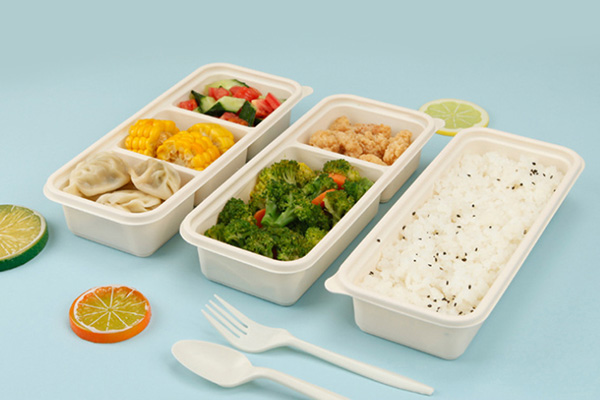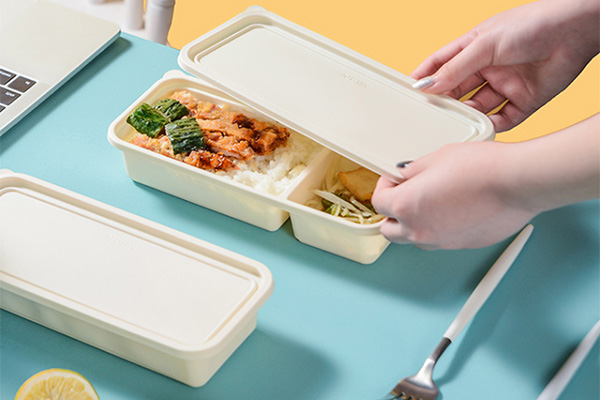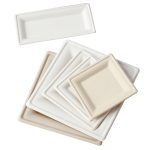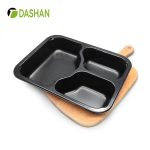Cornstarch salad boxes are eco-friendly, biodegradable, multi-compartment containers designed for salads, fruits, and meal prep. With leak-proof lids, grease resistance, and moderate heat retention, they combine functionality with sustainability. Ideal for restaurants, supermarkets, and catering businesses aiming to replace single-use plastics with compostable, plant-based packaging.
Introduction
The food packaging industry is undergoing a massive transformation. With global concerns about plastic pollution, governments, businesses, and consumers are actively searching for eco-friendly alternatives to single-use plastics. Among these alternatives, cornstarch-based packaging has quickly gained popularity due to its biodegradability, food safety, and versatile applications.
One of the most innovative uses of this material is in cornstarch salad boxes—rectangular containers designed with multiple compartments, leak-resistant lids, and moderate heat retention. These boxes are not only functional but also sustainable, making them ideal for restaurants, supermarkets, catering businesses, and health-conscious meal services.
In this article, we’ll explore the design, material, benefits, applications, market trends, and frequently asked questions about cornstarch salad boxes.
Design Features of Cornstarch Salad Boxes
Cornstarch salad boxes are designed to balance eco-friendliness with functionality. Their practical structure and thoughtful features make them suitable for a wide range of meals.
1. Rectangular Shape with Multiple Compartments
Unlike round or single-compartment containers, cornstarch salad boxes come in rectangular shapes with various partition options:
-
Two Compartments (50:50 ratio): Best for balanced meals, such as salad + fruit or protein + grains.
-
Two Compartments (30:70 ratio): Perfect for a main dish plus a smaller side portion, e.g., pasta + salad.
-
Three Compartments: Ideal for complete meal sets where the main dish, salad, and dessert remain separate.
These compartments keep food fresh, prevent flavors from mixing, and enhance meal presentation.
2. Detachable Leak-Resistant Lid
Cornstarch salad boxes typically feature separate lids designed for a secure fit. This prevents leakage even with oily or saucy foods. Unlike hinged containers, these lids can be easily removed and resealed, offering flexibility for both consumers and food service staff.
3. Moderate Heat Retention
While primarily used for cold meals like salads, fruits, and poke bowls, cornstarch salad boxes also offer insulation benefits. They help maintain food temperature for short periods, making them suitable for warm side dishes or mixed meals.
4. Sturdy and Grease-Resistant Structure
Cornstarch containers resist oil and moisture, ensuring that even foods with dressings or sauces remain intact. They are also durable enough to withstand stacking and transport, which is essential for catering and delivery services.

Material & Sustainability
The key advantage of cornstarch salad boxes lies in their material composition.
What Is Cornstarch Packaging?
Cornstarch packaging is made from polylactic acid (PLA) derived from corn starch or other plant-based sugars. Through fermentation and polymerization, starch is transformed into a biodegradable bioplastic.
Sustainability Benefits
-
Biodegradability: Cornstarch containers break down under industrial composting conditions within months, unlike plastics which persist for centuries.
-
Renewable Resource: Made from plants, not petroleum, helping reduce dependence on fossil fuels.
-
Lower Carbon Footprint: The production of cornstarch bioplastics typically emits less CO₂ compared to conventional plastics.
-
Non-Toxic and Food-Safe: Free from harmful chemicals like BPA, ensuring consumer safety.
Comparison with Plastic Packaging
-
PP & PET Plastic: Durable, affordable, recyclable but still petroleum-based.
-
Cornstarch Boxes: Compostable, eco-friendly, slightly higher cost but aligned with sustainability goals.
For eco-conscious businesses, this trade-off is worth the investment.
Functional Benefits of Cornstarch Salad Boxes
-
Eco-Friendly: 100% biodegradable and compostable.
-
Leak-Proof Design: Secure lids prevent spills during transport.
-
Grease & Oil Resistance: Suitable for dressings, sauces, and oily foods.
-
Temperature Resistant: Works for both chilled salads and moderately warm foods.
-
Customizable Options: Available in different compartment ratios and branding opportunities.
-
Stackable & Space-Saving: Convenient for storage, transport, and catering events.
-
Premium Appearance: Smooth texture and neat compartment divisions enhance food presentation.

Applications of Cornstarch Salad Boxes
Cornstarch salad boxes are versatile and widely adopted in different sectors of the food industry:
-
Restaurants & Cafés: Ideal for dine-in, takeaway, and delivery of fresh salads, poke bowls, and meal combos.
-
Supermarkets: Used for ready-to-eat meals, fruit packs, or mixed food trays.
-
Meal Prep Services: Perfect for diet-focused businesses offering portion-controlled meals.
-
Corporate Catering: Provides an eco-friendly solution for office lunches and events.
-
Festivals & Events: Combines sustainability with practicality in large-scale food service.
Market Trends & Consumer Preferences
The demand for eco-friendly packaging continues to rise due to:
-
Government Regulations: Many countries in Europe, North America, and Asia are banning single-use plastics, pushing businesses toward biodegradable options.
-
Consumer Awareness: A 2024 Nielsen survey found that 73% of global consumers are willing to pay more for sustainable packaging.
-
Growth of Health & Wellness Industry: Salad bars, poke bowl shops, and meal prep services are booming, all requiring eco-friendly packaging solutions.
-
Brand Differentiation: Companies adopting cornstarch packaging gain a marketing advantage by aligning with sustainability values.
Industry experts predict that the biodegradable packaging market will reach $25 billion by 2030, with cornstarch-based containers playing a significant role.
Frequently Asked Questions (FAQ)
1. Are cornstarch salad boxes microwave-safe?
Yes, they can withstand moderate heating, but extended exposure to very high temperatures is not recommended.
2. How long does it take for cornstarch boxes to biodegrade?
In industrial composting facilities, they typically break down within 3–6 months.
3. Are cornstarch salad boxes suitable for liquids or soups?
They are designed for salads and solid meals. For soups or very hot liquids, molded fiber or PLA-lined containers are better options.
4. Do they cost more than plastic containers?
Yes, slightly. However, businesses often see higher customer satisfaction and improved brand image, which offsets the cost.
5. Can these boxes be customized with branding?
Yes, they can be produced in different sizes, colors, and with embossed or printed branding for businesses.
6. Are cornstarch boxes certified for food contact safety?
Reputable manufacturers provide certifications such as FDA, LFGB, or EU food-grade compliance.
Conclusion
Cornstarch salad boxes are more than just containers—they represent a sustainable shift in the food packaging industry. With their multi-compartment rectangular design, leak-resistant lids, grease resistance, and compostable material, they meet the demands of modern consumers and businesses alike.
As global regulations tighten and eco-consciousness rises, switching to cornstarch packaging is no longer just an option—it’s a business necessity for food brands that want to stay competitive and responsible.
For restaurants, supermarkets, and catering services looking for a balance between sustainability, performance, and presentation, cornstarch salad boxes are the future of eco-friendly food packaging.
References
-
European Bioplastics. “Bioplastics Market Data.” https://www.european-bioplastics.org/market/
-
Packaging Europe. “The Rise of Compostable Packaging in Foodservice.” https://packagingeurope.com/
-
Nielsen IQ. “Sustainable Consumer Trends 2024.” https://nielseniq.com/
-
Food Packaging Forum. “Biodegradable and Compostable Packaging Explained.” https://www.foodpackagingforum.org/




